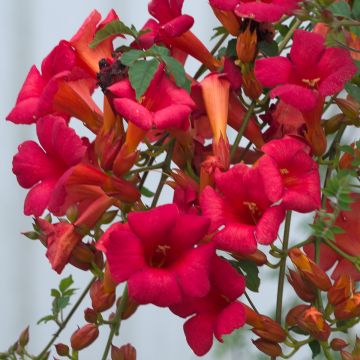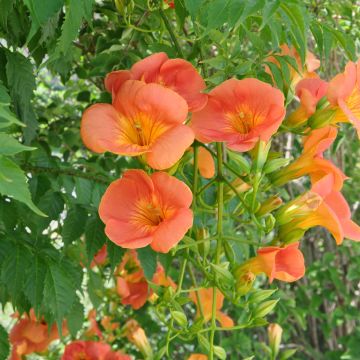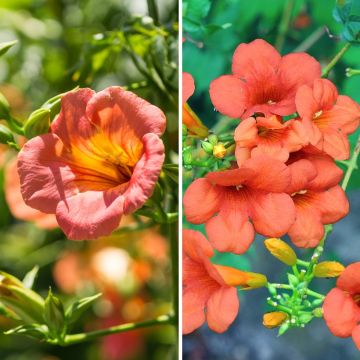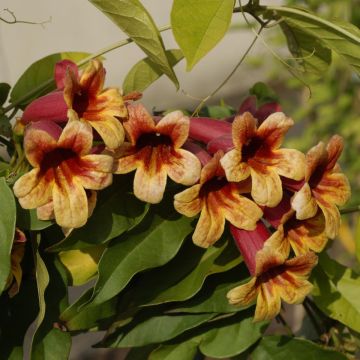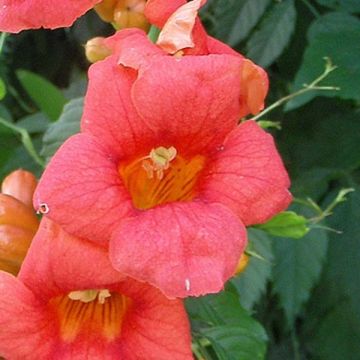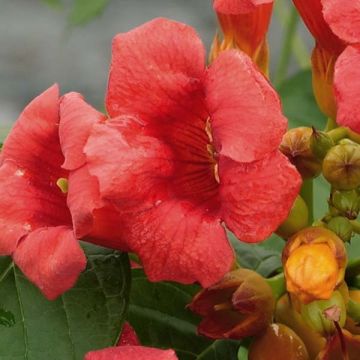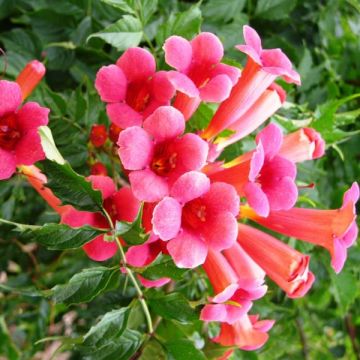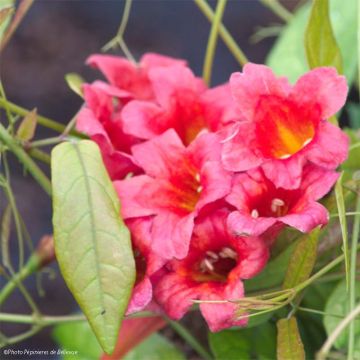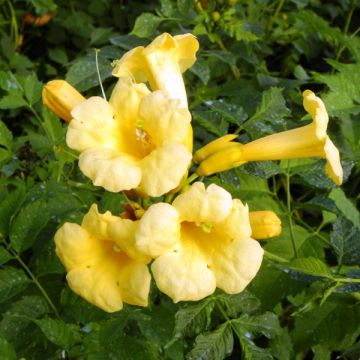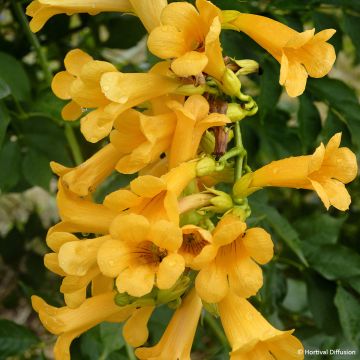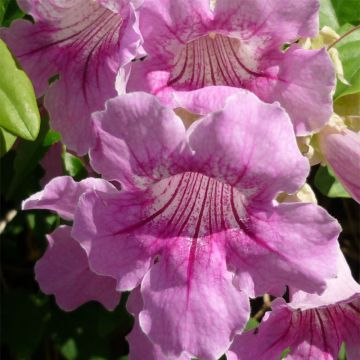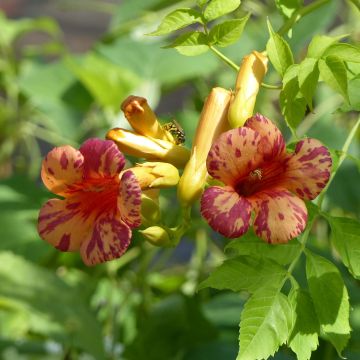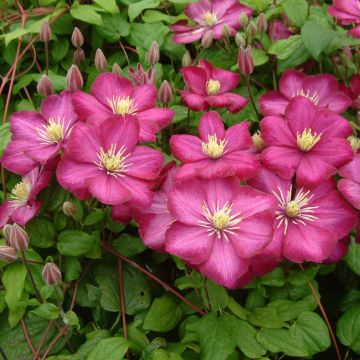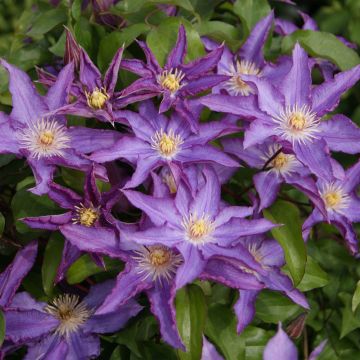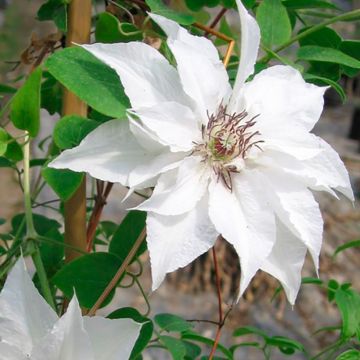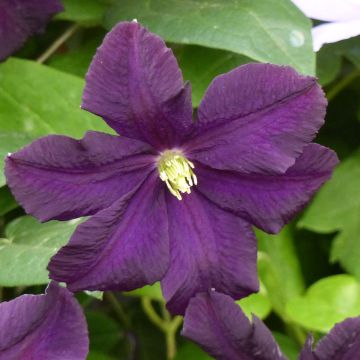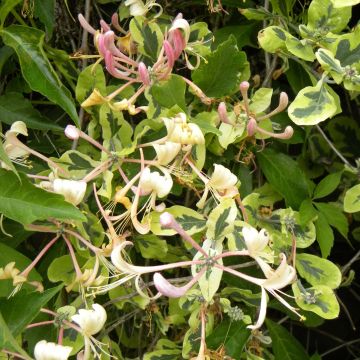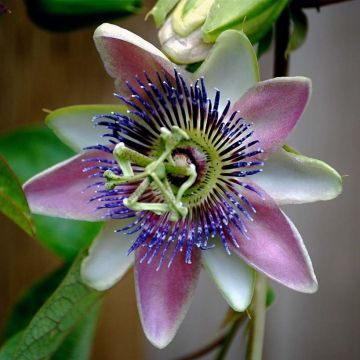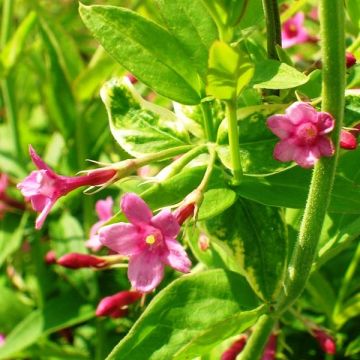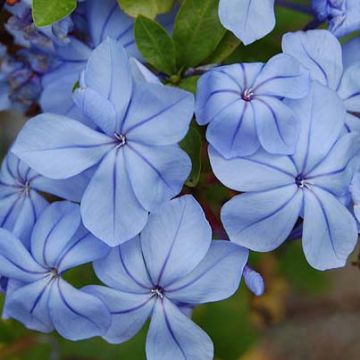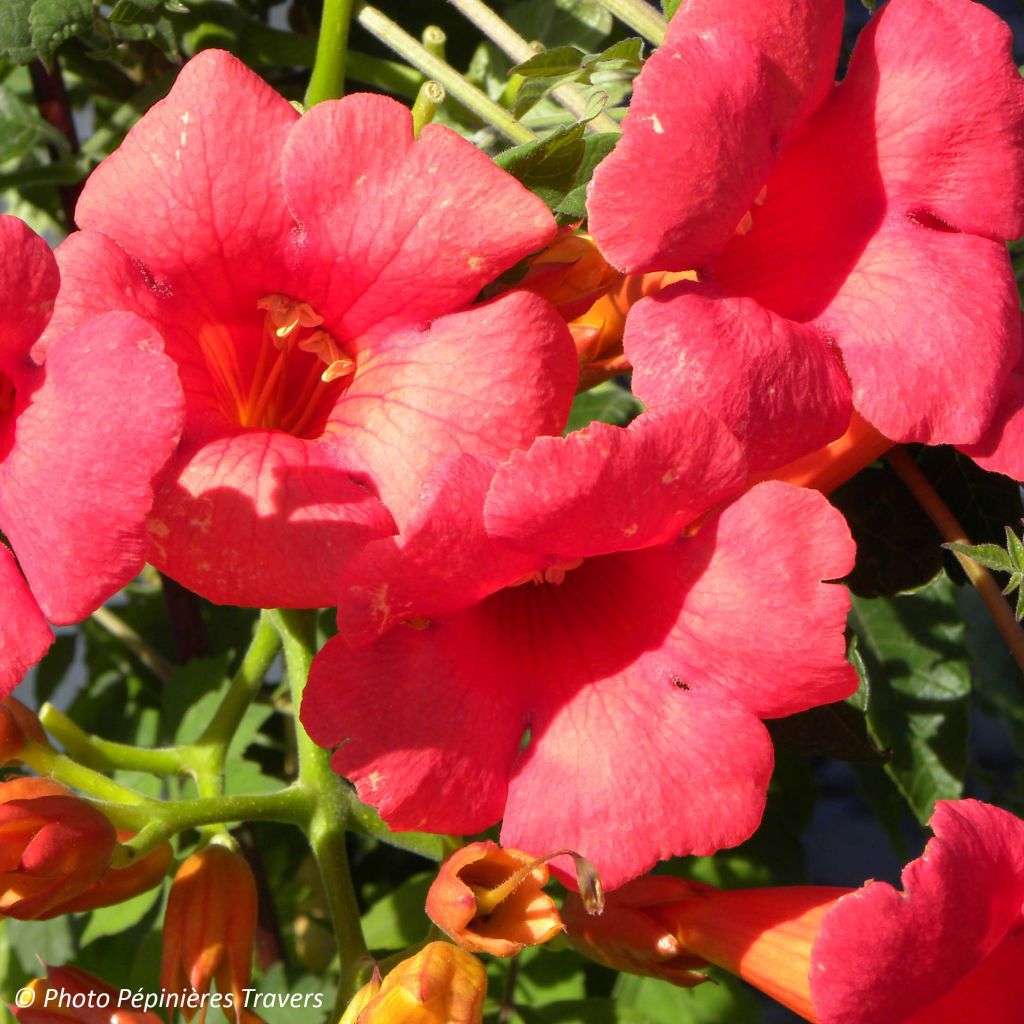

Campsis radicans x grandiflora Grenadine 'Rutcam'
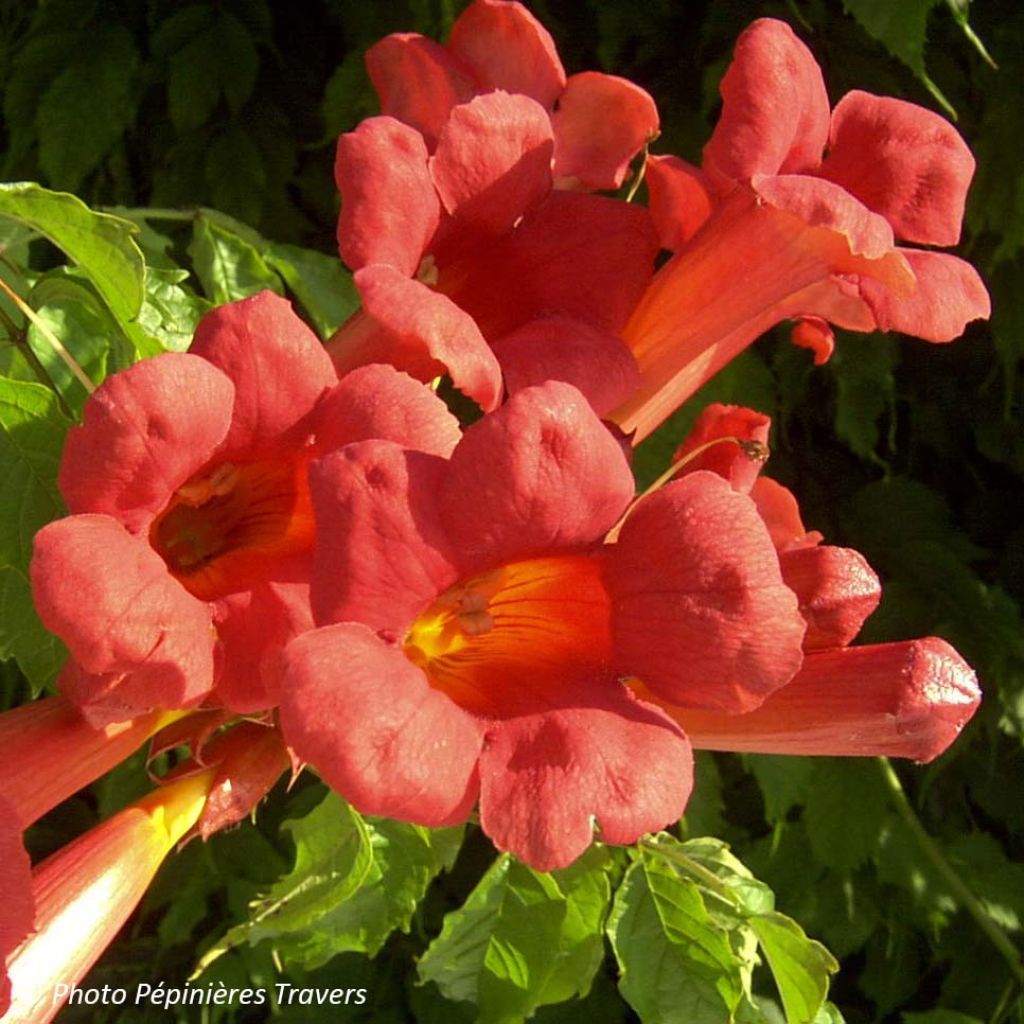

Campsis radicans x grandiflora Grenadine 'Rutcam'
Campsis radicans x grandiflora Grenadine 'Rutcam'
Campsis radicans x grandiflora Grenadine ® 'Rutcam'
Trumpet Vine
Received plant at the end of April and it has grown 4 beautiful 1.5m (5ft) stems this summer. No flowers this year. I hope it will survive the winter and bloom in 2021.
Nadine, 04/10/2020
Why not try an alternative variety in stock?
View all →This plant carries a 6 months recovery warranty
More information
We guarantee the quality of our plants for a full growing cycle, and will replace at our expense any plant that fails to recover under normal climatic and planting conditions.
From €5.90 for pickup delivery and €6.90 for home delivery
Express home delivery from €8.90.
Does this plant fit my garden?
Set up your Plantfit profile →
Description
Campsis Grenadine Rutcam' is a new hybrid trumpet vine that stands out from other varieties due to its vigour, as well as the early flowering, abundance, and duration of its blooms. This vigorous climbing plant displays large, bright red trumpets from June onwards, arranged in loose clusters that continue to bloom until September. The coral red flowers complement the vibrant green foliage, which is beautifully cut. Its tendrils with climbing roots can attach to any available support, whether it be a pergola, a wall or an old tree. Similar to wisteria, this trumpet vine can easily be trained as a tree.
Campsis x tagliabuana is a plant from the Bignoniaceae family, resulting from the cross-breeding of Campsis radicans, native to the hot and dry regions of the southeastern United States, and Campsis grandiflora, native to China. Obtained around 1850 in the Tagliabue brothers' nursery near Milan, it possesses the excellent hardiness of its American parent and the strong climbing roots as well as the large spectacular flowers of its Asian ancestor.
The 'Grenadine' variety is a recent American creation, introduced in 2007. It was actually discovered in a garden in the state of Georgia, USA, as early as 1993. This deciduous climbing vine grows rapidly, reaching over 6m (20ft) in height and 4m (13ft) in width in just a few years. However, its growth can be easily controlled through regular pruning.
'Grenadine' has a woody stump and produces underground runners. The abundant flowering occurs in the first years of cultivation. It starts in June in average climates, sometimes as early as late April in mild climates, and continues until September. The flowers bloom in the axils of the leaves, in 30cm (12in) clusters composed of 6 to 16 trumpets, measuring 7 to 8cm (3in) in length, with 5 lobes. Each flower, with its vibrant red-pink colour and perfectly uniform shade, has a more orangish reverse side. From a distance, the flowering displays an extremely bright red colour. The throat of the flower is occupied by short curved stamens. The deciduous foliage, fairly dark green and yellowish on the underside, is composed of finely cut leaves with 12 ovate leaflets with notched edges. It is not very susceptible to diseases. It is the tendrils with climbing roots that allow the plant to attach to its support.
Campsis x tagliabuana 'Grenadine' can be used anywhere, to cover a wall protected from cold winds, an unsightly building, a well-exposed facade, a fence, a tired wall, or an old gnarled tree. Its tendrils conquer this providential structure, covering its twisted forms with a green and curly hairdo weighed down by clusters of red flpwers, which are splendid for 3 months. At its base, plant violet, blue, and fuchsia sage shrubs, Cerastostigma griffithii with small unreal blue flowers, a perennial pea, mauve and blue asters, and a variegated euphorbia. The mix is magical from June to September. This plant can withstand temperatures as low as -20°C (-4°F). For example, you can combine it with other original climbing plants such as Actinidia kolomikta, Clematis Black Tea, or Clematis H F Young, which is very blue, to create a scene full of colours.
Report an error about the product description
Campsis radicans x grandiflora Grenadine 'Rutcam' in pictures
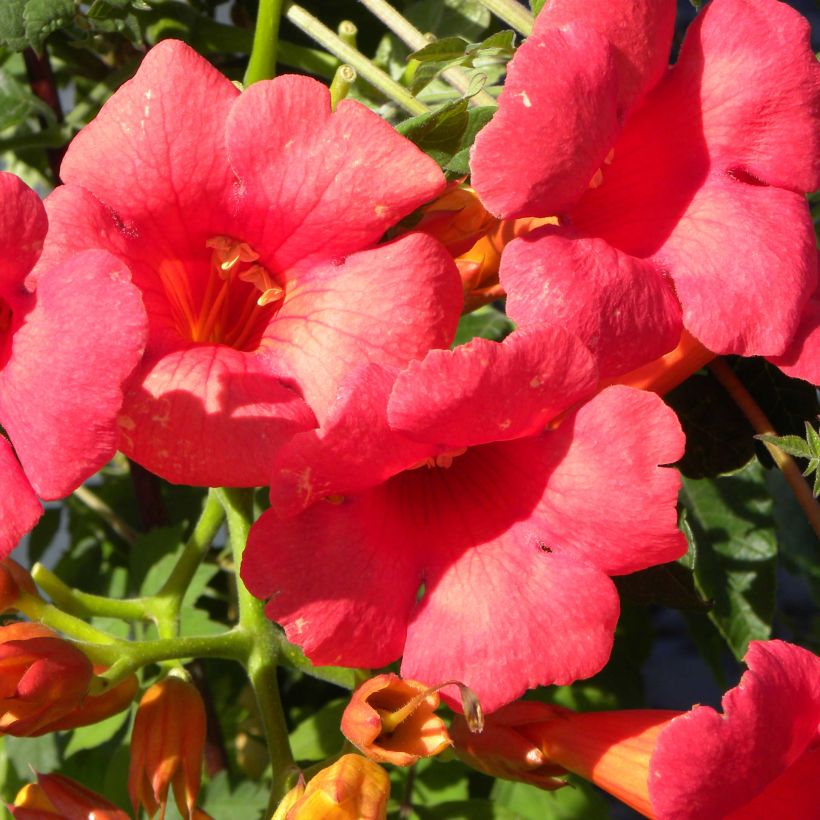

Plant habit
Flowering
Foliage
Botanical data
Campsis
radicans x grandiflora
Grenadine ® 'Rutcam'
Bignoniaceae
Trumpet Vine
Cultivar or hybrid
Other Campsis - Trumpet Creeper
Planting and care
Grenadine trumpet vine is a plant that undemanding on the nature of the soil, but it dreads heavy, compact, poorly drained soils where moisture can stagnate. If the soil in your garden is too heavy, incorporate coarse sand or gravel before planting. It grows well in any well-drained garden soil, even if it is somewhat poor and slightly chalky. It prefers a sunny position, except in hot areas where it will thrive in partial shade. Plant it along a well-exposed wall or against a tree, guiding it with a stake. Water regularly during the first summers, or in case of prolonged drought. The plant can tolerate moderate periods of drought once established, especially if it is planted in deep soil. In the first few years, protect the base from severe frost with a thick mulch. Pruning is not essential. If necessary, prune in late winter or early spring. In August-September, remove faded branches as well as the oldest shoots, recognizable by their split bark. This vine can be trained as a tree, just like a wisteria. Select the most beautiful stem and train it on a sturdy stake, deeply inserted into the ground. Then remove secondary branches up to the desired height to form a trunk. Prune every year by removing stems that detract from the overall appearance.
Trumpet vines are often visited by ants that come to collect the sweet exudates produced by aphids that settle at the tips of the shoots, generally without harming the plant. Powdery mildew can affect the trumpet vine. Watch out for the appearance of mealybugs and the white leafhopper.
Planting period
Intended location
Care
-
, onOrder confirmed
Reply from on Promesse de fleurs
Summer flowering climbers
Haven't found what you were looking for?
Hardiness is the lowest winter temperature a plant can endure without suffering serious damage or even dying. However, hardiness is affected by location (a sheltered area, such as a patio), protection (winter cover) and soil type (hardiness is improved by well-drained soil).

Photo Sharing Terms & Conditions
In order to encourage gardeners to interact and share their experiences, Promesse de fleurs offers various media enabling content to be uploaded onto its Site - in particular via the ‘Photo sharing’ module.
The User agrees to refrain from:
- Posting any content that is illegal, prejudicial, insulting, racist, inciteful to hatred, revisionist, contrary to public decency, that infringes on privacy or on the privacy rights of third parties, in particular the publicity rights of persons and goods, intellectual property rights, or the right to privacy.
- Submitting content on behalf of a third party;
- Impersonate the identity of a third party and/or publish any personal information about a third party;
In general, the User undertakes to refrain from any unethical behaviour.
All Content (in particular text, comments, files, images, photos, videos, creative works, etc.), which may be subject to property or intellectual property rights, image or other private rights, shall remain the property of the User, subject to the limited rights granted by the terms of the licence granted by Promesse de fleurs as stated below. Users are at liberty to publish or not to publish such Content on the Site, notably via the ‘Photo Sharing’ facility, and accept that this Content shall be made public and freely accessible, notably on the Internet.
Users further acknowledge, undertake to have ,and guarantee that they hold all necessary rights and permissions to publish such material on the Site, in particular with regard to the legislation in force pertaining to any privacy, property, intellectual property, image, or contractual rights, or rights of any other nature. By publishing such Content on the Site, Users acknowledge accepting full liability as publishers of the Content within the meaning of the law, and grant Promesse de fleurs, free of charge, an inclusive, worldwide licence for the said Content for the entire duration of its publication, including all reproduction, representation, up/downloading, displaying, performing, transmission, and storage rights.
Users also grant permission for their name to be linked to the Content and accept that this link may not always be made available.
By engaging in posting material, Users consent to their Content becoming automatically accessible on the Internet, in particular on other sites and/or blogs and/or web pages of the Promesse de fleurs site, including in particular social pages and the Promesse de fleurs catalogue.
Users may secure the removal of entrusted content free of charge by issuing a simple request via our contact form.
The flowering period indicated on our website applies to countries and regions located in USDA zone 8 (France, the United Kingdom, Ireland, the Netherlands, etc.)
It will vary according to where you live:
- In zones 9 to 10 (Italy, Spain, Greece, etc.), flowering will occur about 2 to 4 weeks earlier.
- In zones 6 to 7 (Germany, Poland, Slovenia, and lower mountainous regions), flowering will be delayed by 2 to 3 weeks.
- In zone 5 (Central Europe, Scandinavia), blooming will be delayed by 3 to 5 weeks.
In temperate climates, pruning of spring-flowering shrubs (forsythia, spireas, etc.) should be done just after flowering.
Pruning of summer-flowering shrubs (Indian Lilac, Perovskia, etc.) can be done in winter or spring.
In cold regions as well as with frost-sensitive plants, avoid pruning too early when severe frosts may still occur.
The planting period indicated on our website applies to countries and regions located in USDA zone 8 (France, United Kingdom, Ireland, Netherlands).
It will vary according to where you live:
- In Mediterranean zones (Marseille, Madrid, Milan, etc.), autumn and winter are the best planting periods.
- In continental zones (Strasbourg, Munich, Vienna, etc.), delay planting by 2 to 3 weeks in spring and bring it forward by 2 to 4 weeks in autumn.
- In mountainous regions (the Alps, Pyrenees, Carpathians, etc.), it is best to plant in late spring (May-June) or late summer (August-September).
The harvesting period indicated on our website applies to countries and regions in USDA zone 8 (France, England, Ireland, the Netherlands).
In colder areas (Scandinavia, Poland, Austria...) fruit and vegetable harvests are likely to be delayed by 3-4 weeks.
In warmer areas (Italy, Spain, Greece, etc.), harvesting will probably take place earlier, depending on weather conditions.
The sowing periods indicated on our website apply to countries and regions within USDA Zone 8 (France, UK, Ireland, Netherlands).
In colder areas (Scandinavia, Poland, Austria...), delay any outdoor sowing by 3-4 weeks, or sow under glass.
In warmer climes (Italy, Spain, Greece, etc.), bring outdoor sowing forward by a few weeks.

































